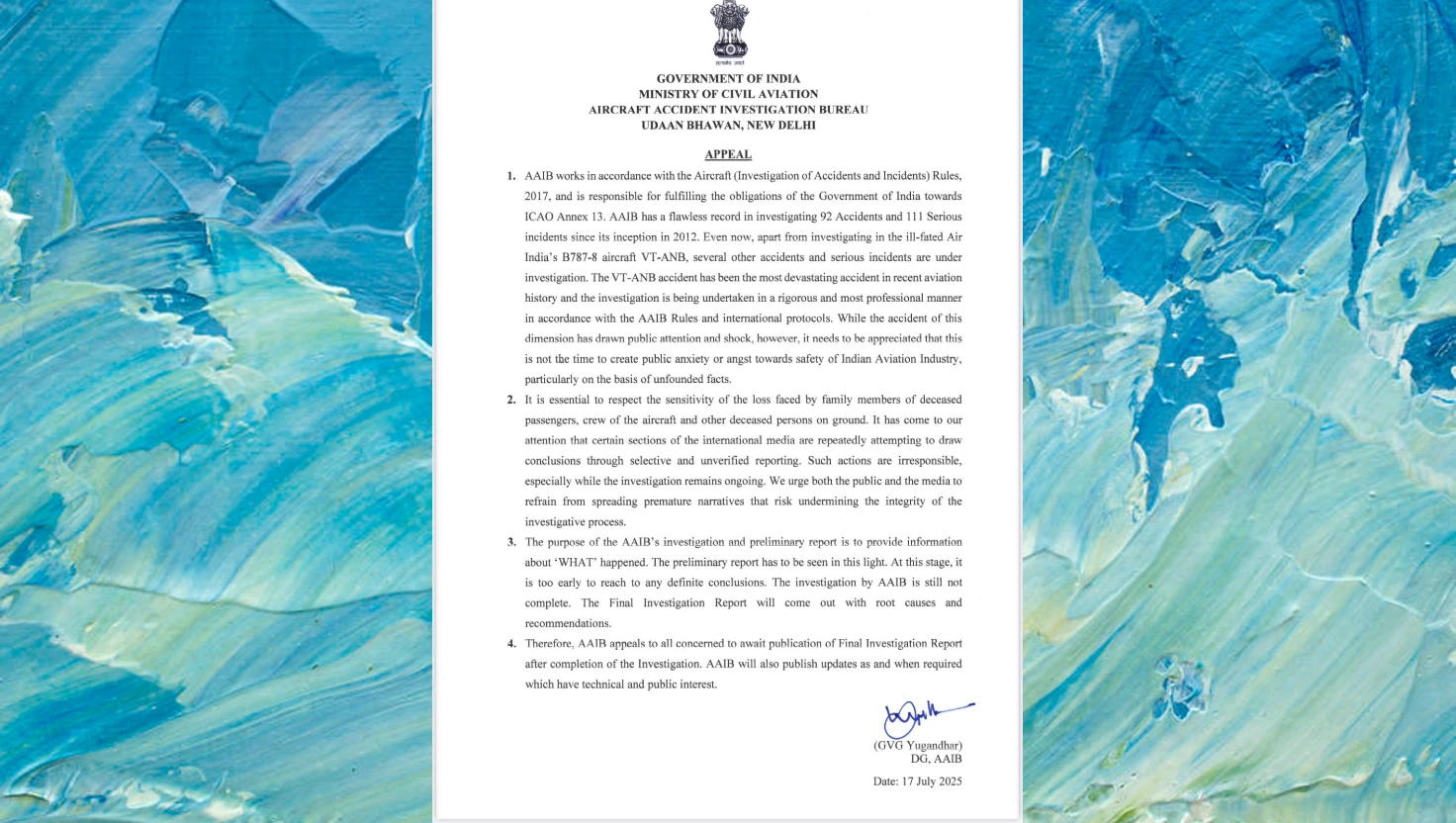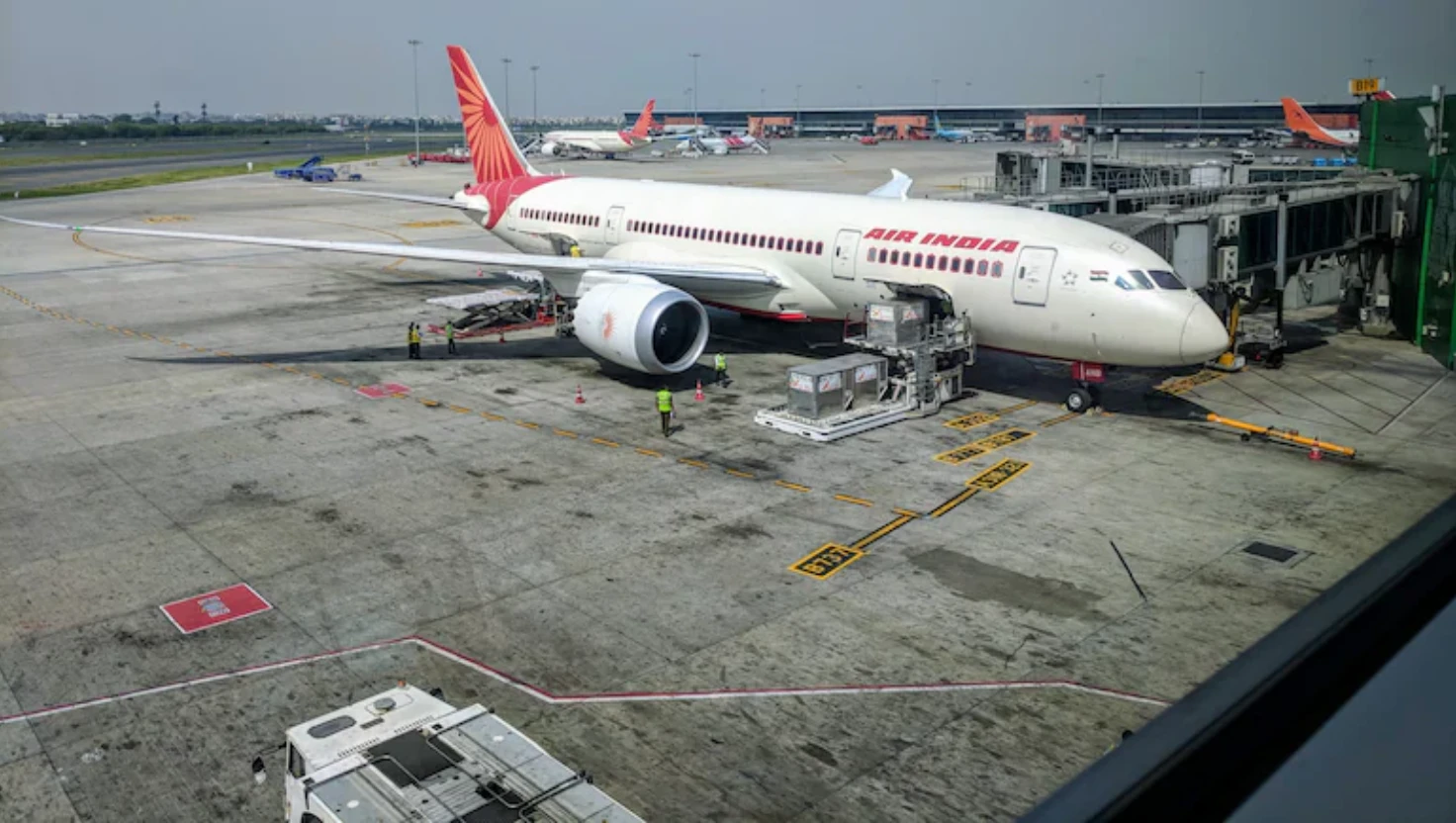Air India Crash Investigation: Pilot Groups Challenge Human Error Claims

The tail of an Air India Boeing 787 Dreamliner is seen stuck on a building after a crash in Ahmedabad, India, on June 12, 2025
Pilot groups dispute human error in Air India crash investigation, urging transparency amid ongoing inquiries into the incident that killed 260.
The Indian Commercial Pilots Association (ICPA) and the Airline Pilots’ Association of India (ALPA India) issued statements on Sunday, expressing their concern over speculative narratives surrounding the crash. This came in response to findings from the preliminary investigation by India's Aircraft Accident Investigation Bureau (AAIB), which revealed that the fuel control switches for the aircraft's engines had been moved from the 'run' to the 'cutoff' position shortly before the plane lost altitude and thrust following takeoff from Ahmedabad.
According to the AAIB report released on Saturday, a conversation was recorded between the flight’s pilots. One pilot questioned the other about the fuel cutoff, leading to confusion over who had made the adjustment. The investigation report noted, "one pilot asked the other why he had cut off the fuel," with the response indicating that no intentional action had been taken.
The crash occurred on June 12, when Flight AI171 was en route to London’s Gatwick Airport. Tragically, it resulted in the death of 242 passengers and crew members onboard and 19 individuals on the ground.
The ICPA has strongly rebuked any insinuations of pilot suicide, stating, "There is absolutely no basis for such a claim at this stage; it is deeply insensitive to the individuals and families involved." The association emphasised the importance of ethical reporting, insisting that such narratives violate the dignity of the profession.
US-based aviation safety expert John Cox commented that moving the fuel control switches is not an action a pilot can take accidentally, describing the switches as requiring deliberate manual operation. He stated, "You can’t bump them and they move."
ALPA India, with a membership of approximately 800 pilots, also raised concerns regarding the transparency of the ongoing investigation. The association’s president, Sam Thomas, remarked that they felt the investigation was being unduly directed towards presuming pilot guilt. He urged that qualified personnel should be involved to ensure transparency and credibility, requesting the AAIB to allow their inclusion as observers.
In response to the incident, Air India’s Chief Executive Officer, Campbell Wilson, highlighted that the probe into the crash remains ongoing and cautioned against drawing premature conclusions. He stated, "The preliminary report identified no cause nor made any recommendations, so I urge everyone to avoid drawing premature conclusions as the investigation is far from over."
On a related note, following the preliminary findings, India’s Directorate General of Civil Aviation (DGCA) ordered airlines to inspect the fuel switch locking mechanisms across their Boeing 787 fleets. This directive, issued on Monday, instructs airlines to comply with a previous safety bulletin by the US Federal Aviation Administration concerning fuel control switches.
The DGCA’s instruction requires all Indian airlines to complete these inspections by July 21, 2025, citing safety awareness following the shocking results of the crash investigation.
Major airlines worldwide, including Etihad Airways and Singapore Airlines, are also reviewing the locking mechanisms in Boeing 787 aircraft, despite the FAA and Boeing maintaining that the current locking system is safe.
The AAIB report further noted that Air India had not previously conducted the recommended inspections as outlined in the Special Airworthiness Information Bulletin. This bulletin, issued in 2018, indicated concerns but did not classify the condition as unsafe.
In conclusion, the investigation into the Air India crash continues, and various stakeholders in the aviation industry remain watchful as they await further findings that might clarify the circumstances surrounding this tragic event.
According to the AAIB report released on Saturday, a conversation was recorded between the flight’s pilots. One pilot questioned the other about the fuel cutoff, leading to confusion over who had made the adjustment. The investigation report noted, "one pilot asked the other why he had cut off the fuel," with the response indicating that no intentional action had been taken.
The crash occurred on June 12, when Flight AI171 was en route to London’s Gatwick Airport. Tragically, it resulted in the death of 242 passengers and crew members onboard and 19 individuals on the ground.
The ICPA has strongly rebuked any insinuations of pilot suicide, stating, "There is absolutely no basis for such a claim at this stage; it is deeply insensitive to the individuals and families involved." The association emphasised the importance of ethical reporting, insisting that such narratives violate the dignity of the profession.
US-based aviation safety expert John Cox commented that moving the fuel control switches is not an action a pilot can take accidentally, describing the switches as requiring deliberate manual operation. He stated, "You can’t bump them and they move."
ALPA India, with a membership of approximately 800 pilots, also raised concerns regarding the transparency of the ongoing investigation. The association’s president, Sam Thomas, remarked that they felt the investigation was being unduly directed towards presuming pilot guilt. He urged that qualified personnel should be involved to ensure transparency and credibility, requesting the AAIB to allow their inclusion as observers.
In response to the incident, Air India’s Chief Executive Officer, Campbell Wilson, highlighted that the probe into the crash remains ongoing and cautioned against drawing premature conclusions. He stated, "The preliminary report identified no cause nor made any recommendations, so I urge everyone to avoid drawing premature conclusions as the investigation is far from over."
On a related note, following the preliminary findings, India’s Directorate General of Civil Aviation (DGCA) ordered airlines to inspect the fuel switch locking mechanisms across their Boeing 787 fleets. This directive, issued on Monday, instructs airlines to comply with a previous safety bulletin by the US Federal Aviation Administration concerning fuel control switches.
The DGCA’s instruction requires all Indian airlines to complete these inspections by July 21, 2025, citing safety awareness following the shocking results of the crash investigation.
Major airlines worldwide, including Etihad Airways and Singapore Airlines, are also reviewing the locking mechanisms in Boeing 787 aircraft, despite the FAA and Boeing maintaining that the current locking system is safe.
The AAIB report further noted that Air India had not previously conducted the recommended inspections as outlined in the Special Airworthiness Information Bulletin. This bulletin, issued in 2018, indicated concerns but did not classify the condition as unsafe.
In conclusion, the investigation into the Air India crash continues, and various stakeholders in the aviation industry remain watchful as they await further findings that might clarify the circumstances surrounding this tragic event.

Reliance Retail acquires Kelvinator, The Coolest One
Reliance Retail has purchased the Kelvinator brand from Electrolux for nearly ₹160 crore, aiming to strengthen its position in India's consumer durables market.
| 2025-07-19

Saiyyara has shattered every myth about launching newcomers. No big names, no big PR
Madhur Bhandarkar praises debut film 'Saiyaara' for its raw talent and storytelling, marking a shift in Bollywood's approach to newcomers.
| 2025-07-19

India slams reports blaming pilots for Air India crash
India's AAIB disputes US media assertions regarding Air India AI 171 crash, highlighting ongoing investigation and sensitivity towards victims' families.
| 2025-07-18

India Secures Four-Wicket Win in ODI Series Opener Against England
India achieves a four-wicket victory over England in the ODI series opener, led by Deepti Sharma's unbeaten 62 runs.
| 2025-07-17

Air India inspection claims no problems found with Boeing 787 fuel control switches
Air India has conducted thorough inspections of its Boeing 787 fuel control switches, reporting no problems following a DGCA directive.
| 2025-07-17




